Astronomy fanatica
-
Astronomy Picture of the Day
2005 August 24
Epimetheus: A Small Moon of Saturn
Explanation: How did Epimetheus form? No one is yet sure. To help answer that question, this small moon has recently been imaged again in great detail by the robot spacecraft Cassini now orbiting Saturn. Epimetheus sometimes orbits Saturn in front of Janus, another small satellite, but sometimes behind. The above false-color image, taken during mid July, shows a surface covered with craters indicating great age. Epimetheus spans about 115 kilometers across. Epimetheus does not have enough surface gravity to restructure itself into a sphere.
Credit: Cassini Imaging Team, SSI, JPL, ESA, NASA -
Astronomy Picture of the Day
2005 August 25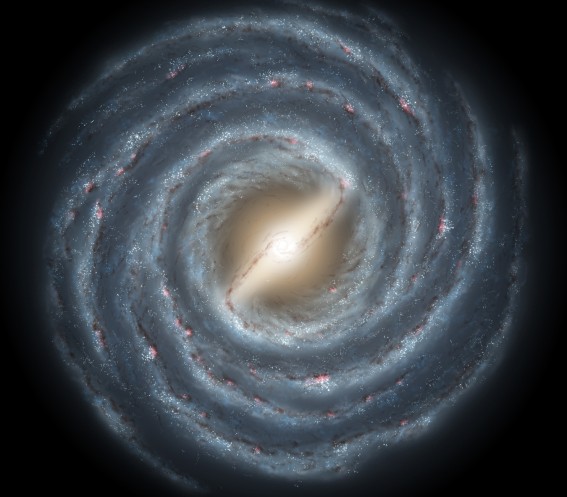
Barred Spiral Milky Way
Explanation: A recent survey of stars conducted with the Spitzer Space Telescope is convincing astronomers that our Milky Way Galaxy is not just your ordinary spiral galaxy anymore. Looking out from within the Galaxy's disk, the true structure of the Milky Way is difficult to discern. However, the penetrating infrared census of about 30 million stars indicates that the Galaxy is distinguished by a very large central bar some 27,000 light-years long. In fact, from a vantage point that viewed our galaxy face-on, astronomers in distant galaxies would likely see a striking barred spiral galaxy suggested in this artist's illustration. While previous investigations have identified a small central barred structure, the new results indicate that the Milky Way's large bar would make about a 45 degree angle with a line joining the Sun and the Galaxy's center. DON'T PANIC ... astronomers still place the Sun beyond the central bar region, about a third of the way in from the Milky Way's outer edge.
Illustration Credit: R. Hurt (SSC), JPL-Caltech, NASA
Survey Credit: GLIMPSE Team -
Astronomy Picture of the Day
2005 August 26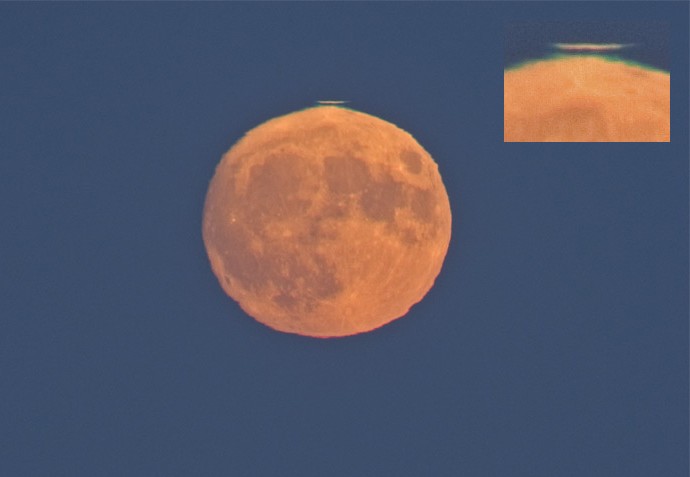
Full Moon, Green Rim
Explanation: July's Full Moon looks strangely darkened and distorted in this remarkable telescopic view. The image is one of a series recorded when the Moon was very near the horizon. The long sight-line through a turbulent atmosphere gives rise to the tantalizing optical effects, including the thin "mirage" shape that seems to float just above the Moon's upper edge. Also seen (more easily in the inset), along the Moon's upper edge is a noticeable green rim. Substantial atmospheric refraction produces this prism-like effect -- related to the more commonly witnessed green flash of the setting Sun. Careful inspection of the full image reveals a corresponding red rim along the lower edge, another intriguing signature of atmospheric refraction.
Credit & Copyright: Laurent Laveder (PhotoAstronomique.net) -
Astronomy Picture of the Day
2005 August 27
3D International Space Station
Explanation: Get out your red-blue glasses and float next to the International Space Station (ISS), planet Earth's largest artificial moon. This breathtaking stereo view was constructed from two separate images (S114-E-7245, S114-E-7246) recorded as the shuttle orbiter Discovery undocked from the ISS on August 6. As seen here, the ISS is around 27 meters (90 feet) tall. The span from the automated Progress supply ship docked in the foreground to the Destiny module hidden behind the station structure is about 52 meters (171 feet) long, while the full reach of the solar arrays across the top would cover about 73 meters (240 feet). Resupplied by Discovery, the ISS is currently operated by the two member Expedition 11 crew, Sergei Krikalev and John Phillips.
Credit: STS-114 Crew, NASA - Stereo Image: Patrick Vantuyne -
Astronomy Picture of the Day
2005 August 28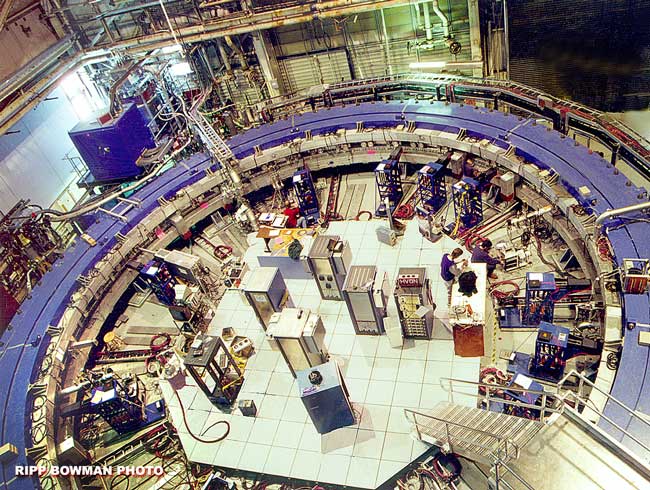
Muon Wobble Possible Door to Supersymmetric Universe
Explanation: How fast do fundamental particles wobble? A surprising answer to this seemingly inconsequential question has come out of Brookhaven National Laboratory in New York, USA and may not only indicate that the Standard Model of Particle Physics is incomplete but also that our universe is filled with a previously undetected type of fundamental particle. Specifically, the muon, a particle with similarities to a heavy electron, has had its relatively large wobble under scrutiny since 1999 in an experiment known as g-2 (gee-minus-two), pictured above. The result has galvanized other experimental groups around the world to confirm it, and pressures theorists to better understand it. The rate of wobble is sensitive to a strange sea of virtual particles that pop into and out of existence everywhere. The unexpected wobble rate may indicate that this sea houses virtual particles that include nearly invisible supersymmetric counterparts to known particles. If so, a nearly invisible universe of real supersymmetric particles might exist all around us.
Credit: R. Bowman, g-2 Collaboration, BNL, DOE -
Astronomy Picture of the Day
2005 August 29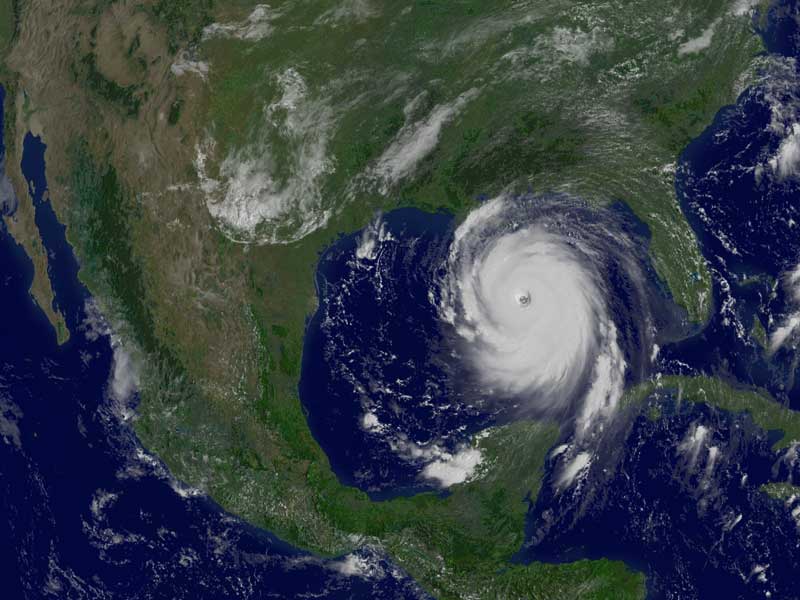
Hurricane Katrina in the Gulf of Mexico
Explanation: Where will Hurricane Katrina go? One of the stronger storm systems of modern times appears headed for landfall somewhere in the southern USA sometime today. Katrina was designated yesterday a rare Category 5 Hurricane, the strongest designation for a storm on Earth, and one that indicates sustained winds greater than 250 kilometers per hour. Pictured above is a digitally processed image from the orbiting GOES-12 weather satellite that shows the massive storm system yesterday in the Gulf of Mexico. Starting as a slight pressure difference, hurricanes grow into large spiraling storm systems of low pressure, complete with high winds and driving rain. A hurricane is powered by evaporating ocean water, and so typically gains strength over warm water and loses strength over land. Much remains unknown about hurricanes and cyclones, including how they are formed and the exact path they will take.
Credit: GOES 12 Satellite, NASA, NOAA -
Astronomy Picture of the Day
2005 August 30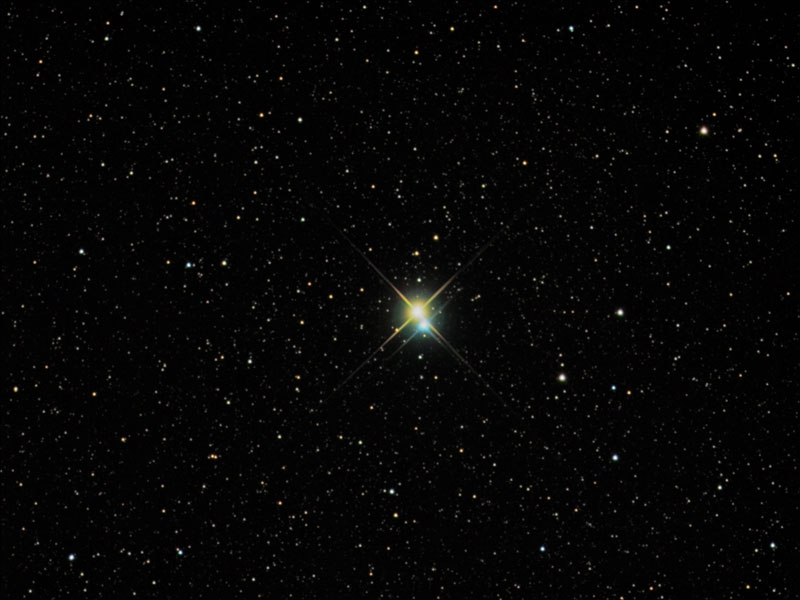
Albireo: A Bright and Beautiful Double
Explanation: Sometimes, even a small telescope can help unlock a hidden beauty of the heavens. Such is the case of the bright double star Albireo. Seen at even slight magnification, Albireo unfolds from a bright single point into a beautiful double star of strikingly different colors. At 380 light years distant, the two bright stars of Albireo are comparatively far from each other and take over 7000 years to complete a single orbit. The brighter yellow star is itself a binary star system, but too close together to be resolved even with a telescope. Albireo, pictured above, is the second brightest star system toward the constellation of the Swan (Cygnus) and easily visible to the unaided eye.
Credit & Copyright: Richard Yandrick (Cosmicimage.com) -
Astronomy Picture of the Day
2005 August 31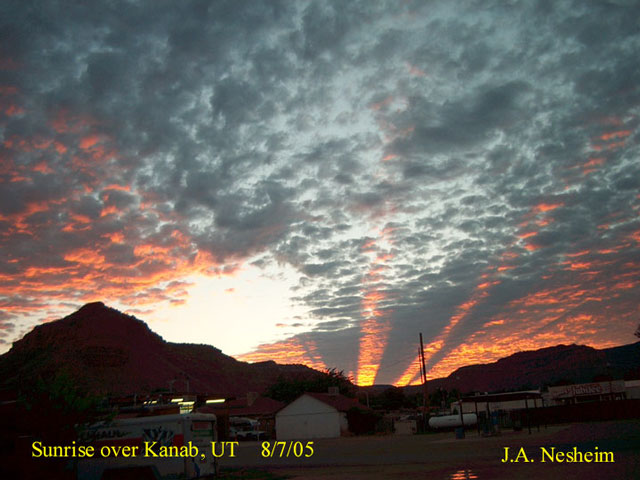
Crepuscular Rays Over Utah
Explanation: What could cause such rays of dark? Dark sky rays were caught in spectacular fashion earlier this month above Utah, USA. The cause is something surprisingly familiar: shadows. Clouds near the horizon can block sunlight from reflecting off air, making columns outward from the Sun appear unusually dark. Cloud shadows can be thought of the complement of the more commonly highlighted crepuscular rays, also visible above, where sunlight pours though cloud holes. Sometimes, on the opposite side of the sky, anticrepuscular rays can also be seen.
Credit & Copyright: Jean Nesheim -
Astronomy Picture of the Day
2005 September 1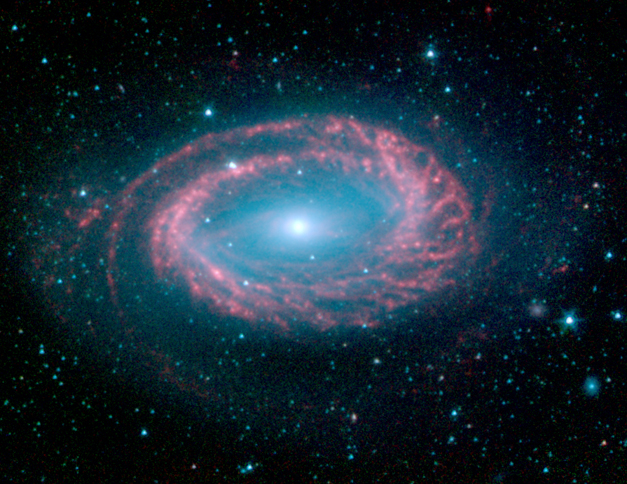
One-Armed Spiral Galaxy NGC 4725
Explanation: While most spiral galaxies, including our own Milky Way, have two or more spiral arms, peculiar galaxy NGC 4725 has only one. In this false-color Spitzer Space Telescope infrared image, the galaxy's solo spira mirabilis is seen in red, highlighting the emission from dust clouds warmed by newborn stars. The blue color is light from NGC 4725's population of old stars. Also sporting a prominent ring and a central bar, this galaxy is over 100 thousand light-years across and lies 41 million light-years away in the well-groomed constellation Coma Berenices. Computer simulations of the formation of single spiral arms suggest that they can be either leading or trailing arms with respect to a galaxy's overall rotation.
Credit: R. Kennicutt (Univ. Arizona), SINGS Team, JPL-Caltech, NASA -
Astronomy Picture of the Day
2005 September 2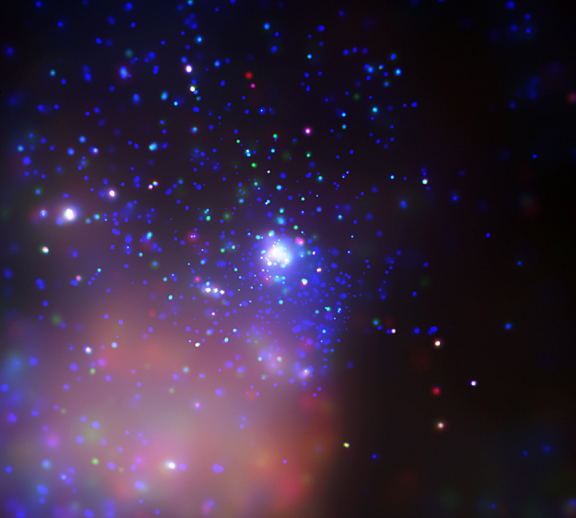
X-Ray Portrait of Trumpler 14
Explanation: A wonder of planet Earth's southern sky, star cluster Trumpler 14 lies about nine thousand light-years away in the Carina complex -- a rich star forming region at the edge of a giant molecular cloud. This false-color x-ray portrait of Trumpler 14 from the orbiting Chandra Observatory spans over 40 light-years and reveals stunning details of a cluster with one of the highest concentrations of massive stars in the Galaxy. Profoundly affecting their environment, the hot cluster stars are themselves a mere one million years old. Energetic winds from the stars have cleared out a cavity in the dense cloud, filling it with shock heated, x-ray emitting gas. Still to come, the next few million years will see these stellar prodigies rapidly exhaust their nuclear fuel and explode in violent supernovae, flooding their cosmic neighborhood with gas enriched in heavy elements.
Credit: L. Townsley (PSU) et al., CXC, NASA -
Astronomy Picture of the Day
2005 September 3
Venus Unveiled
Explanation: The surface of Venus is perpetually covered by a veil of thick clouds and remains hidden from even the powerful telescopic eyes of earth-bound astronomers. But in the early 1990s, using imaging radar, the Venus orbiting Magellan spacecraft was able to lift the veil from the face of Venus and produced spectacular high resolution images of the planet's surface. Colors used in this computer generated picture of Magellan radar data are based on color images from the surface of Venus transmitted by the Soviet Venera 13 and 14 landers. The bright area running roughly across the middle represents the largest highland region of Venus known as Aphrodite Terra.
Credit: Magellan Project, JPL, NASA -
Astronomy Picture of the Day
2005 September 4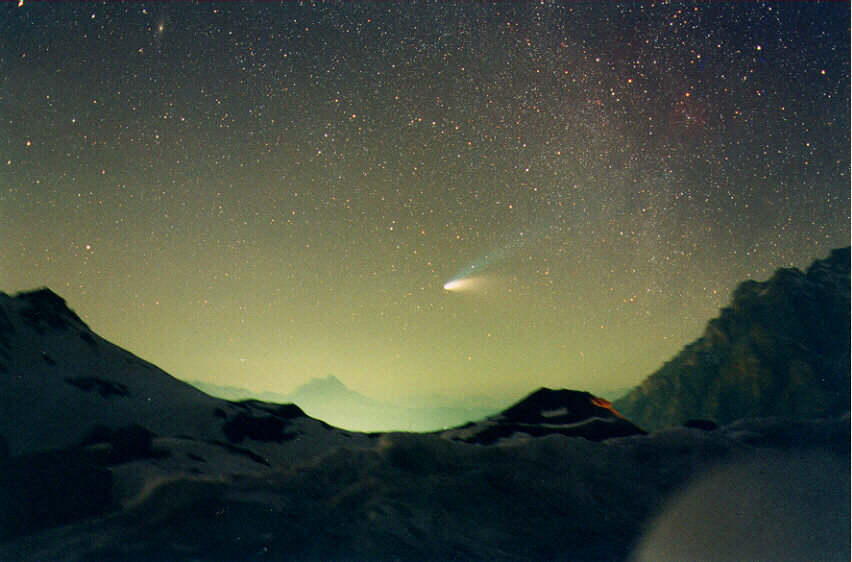
Comet Hale-Bopp Over Val Parola Pass
Explanation: Comet Hale-Bopp became much brighter than any surrounding stars. It was seen even over bright city lights. Out away from city lights, however, it put on quite a spectacular show. Here Comet Hale-Bopp was photographed above Val Parola Pass in the Dolomite mountains surrounding Cortina d'Ampezzo, Italy. Comet Hale-Bopp's blue ion tail was created when fast moving particles from the solar wind struck expelled ions from the comet's nucleus. The white dust tail is composed of larger particles of dust and ice expelled by the nucleus that orbit behind the comet. Observations showed that Comet Hale-Bopp's nucleus spins about once every 12 hours.
Credit & Copyright: A. Dimai, (Col Druscie Obs.), AAC -
Astronomy Picture of the Day
2005 September 5
Globular Cluster 47 Tucanae from SALT
Explanation: Stars come in bunches. Of the over 200 globular star clusters that orbit the center of our Milky Way Galaxy, 47 Tucanae is the second brightest globular cluster, behind Omega Centauri. Known to some affectionately as 47 Tuc or NGC 104, it is only visible from Earth's Southern Hemisphere. It was therefore a fitting target for first light observations of the gigantic new 10-meter diameter Southern African Large Telescope (SALT) this past week. The resulting image is shown above. Light takes about 20,000 years to reach us from 47 Tuc which can be seen near the Small Magellanic Cloud toward the constellation of Tucana. The dynamics of stars near the center of 47 Tuc are not well understood, particularly why there are so few binary systems there.
Credit: South African Astronomical Observatory -
Astronomy Picture of the Day
2005 September 6
Fresh Tiger Strips on Saturn's Enceladus
Explanation: The tiger stripes on Saturn's moon Enceladus might be active. Even today, they may be spewing ice from the moon's icy interior into space, creating a cloud of fine ice particles over the moon's South Pole and creating Saturn's mysterious E-ring. Recent evidence for this has come from the robot Cassini spacecraft now orbiting Saturn. Cassini detected a marked increase in particle collisions during its July flyby only 270 kilometers over a South Polar region of Enceladus. Pictured above, a high resolution image of Enceladus is shown from the close flyby. The unusual surface features dubbed tiger stripes are visible on the left in false-color blue. Why Enceladus is active remains a mystery, as the neighboring moon Mimas, approximately the same size, appears quite dead.
Credit: Cassini Imaging Team, SSI, JPL, ESA, NASA -
Astronomy Picture of the Day
2005 September 7
The View from Husband Hill on Mars
Explanation: Click on the link above to see a breathtaking panorama of Mars from the top of Husband Hill. The image was taken by the robotic rover Spirit now exploring the red planet. Spirit, situated in expansive Gusev Crater, has been exploring the Columbia Hills for some time including climbing Husband Hill over the last few months. On the way up, Spirit took in a color vista from Larry's Lookout. Visible in the above image is the vast eastern landscape previously blocked from view by the Columbia Hills themselves. The horizon is mostly defined by the rim of Thira crater visible some 15 kilometers in the distance. Spirit will now examine rocks and soil at the top of Husband Hill, looking for clues as to how the hills and local rocks formed in the distant past.
Credit: Mars Exploration Rover Mission, Cornell, JPL, NASA -
Astronomy Picture of the Day
2005 September 8
IC 1396 in Cepheus
Explanation: Stunning emission nebula IC 1396 mixes glowing cosmic gas and dark dust clouds in the high and far off constellation of Cepheus. As pictured here, the star forming region sprawls across hundreds of light-years -- spanning over three degrees on the sky while nearly 3,000 light-years from planet Earth. Among the intriguing dark shapes within IC 1396, the winding Elephant's Trunk nebula lies just below center. The gorgeous color view is a composition of digitized black and white photographic plates recorded through red and blue astronomical filters. The plates were taken using the Samuel Oschin Telescope, a wide-field survey instrument at Palomar Observatory, between 1989 and 1993.
Credit: Digitized Sky Survey, ESA/ESO/NASA FITS Liberator
Color Composite: Davide De Martin (Skyfactory) -
Astronomy Picture of the Day
2005 September 9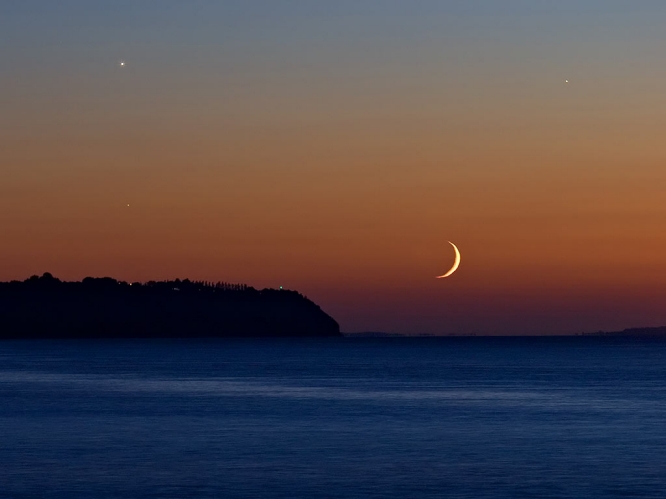
Moon River
Explanation: Shortly after sunset on September 6th, sky gazers around the world were treated to a lovely crescent Moon in western skies -- joined by bright planets Venus and Jupiter. In this colorful telephoto view from near Quebec City, Canada the Moon is nestled just above the wide St. Lawrence River. Lights on the horizon are along the river's southern shore. Also known as the evening star, Venus is at the upper left and Jupiter at the upper right, while another prominent celestial beacon, Spica, can be seen shining through the twilight below Venus. Spica, actually a very close pair of hot blue stars some 260 light-years away, is the brightest star in the constellation Virgo.
Credit & Copyright: Jay Ouellet -
Astronomy Picture of the Day
2005 September 10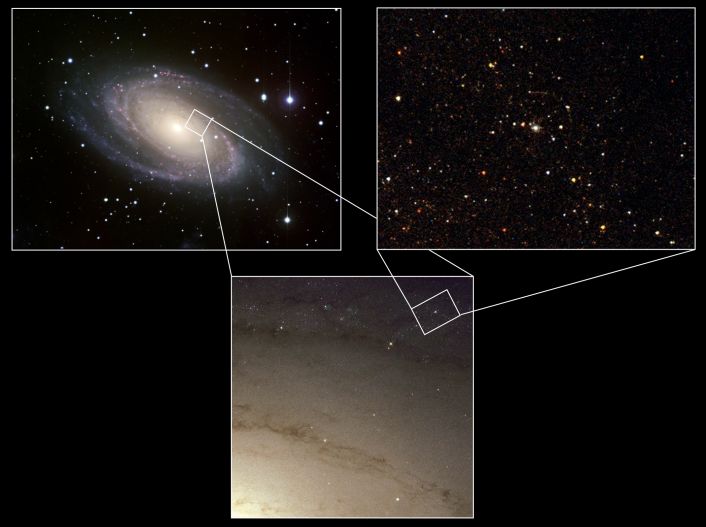
Supernova Survivor
Explanation: Beginning with a full view of beautiful spiral galaxy M81, follow the insets (left, bottom, then right) to zoom in on a real survivor. Seen at the center of the final field on the right is a star identified as the survivor of a cosmic cataclysm -- the supernova explosion of its companion star. Light from the cosmic blast, likely triggered by the core collapse of a star initially more than 10 times as massive as the Sun, first reached Earth over 10 years ago and was cataloged as supernova SN 1993J. Though the supernova itself is no longer visible, light-echoes from dust in the region can still be seen near the companion, the first known survivor of a supernova in a binary star system. Astronomers believe that a substantial transfer of material to the surviving companion star during the last few hundred years before the stellar explosion can explain peculiarities seen in this supernova. After supernova SN 1987A in the Large Magellanic Cloud, SN 1993J in nearby M81 is the brightest supernova seen in modern times.
Credit: Justyn R. Maund (IoA/Univ. Cambridge) et al., ESA
Inset Left: Isaac Newton Telescope,
Bottom: Hubble WFPC2, Right: Hubble ACS -
Astronomy Picture of the Day
2005 September 11
Jupiter's Clouds from Cassini
Explanation: Gas giant Jupiter is the solar system's largest world with about 320 times the mass of planet Earth. Famous for its Great Red Spot, Jupiter is also known for its regular, equatorial cloud bands, visible in very modest sized telescopes. The dark belts and light-colored zones of Jupiter's cloud bands are organized by planet girdling winds which reach speeds of up to 500 kilometers per hour. On toward the Jovian poles though, the cloud structures become more mottled and convoluted until, as in this Cassini spacecraft mosaic of Jupiter, the planet's polar region begins to look something like a brain! This striking equator-to-pole change in cloud patterns is not presently understood but may be due in part to the effect of Jupiter's rapid rotation or to convection vortices generated at high latitudes by the massive planet's internal heat loss. The Cassini spacecraft this dramatically detailed view of Jupiter in 2000 December during its turn of the millennium flyby enroute to Saturn.
Credit: Cassini Imaging Team, Cassini Project, NASA -
Astronomy Picture of the Day
2005 September 12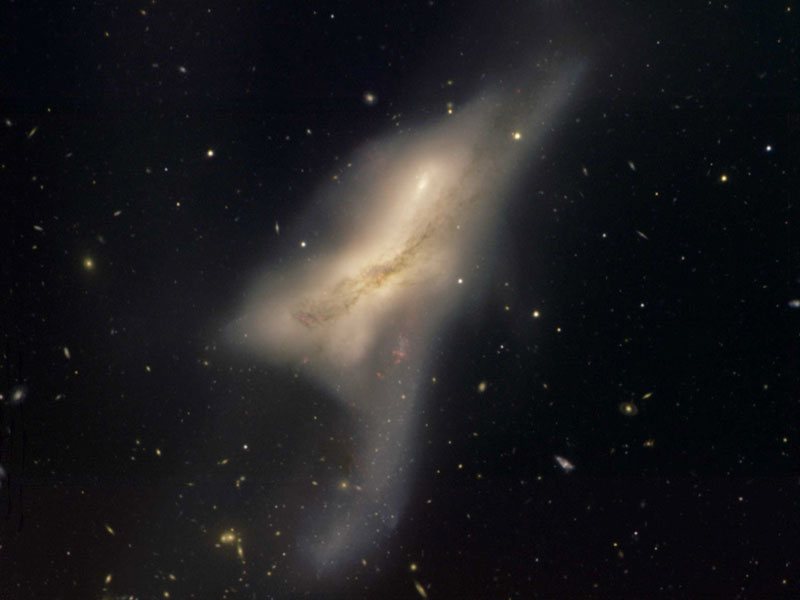
The Colliding Galaxies of NGC 520
Explanation: Is this one galaxy or two? The jumble of stars, gas, and dust that is NGC 520 is now thought to incorporate the remains of two separate galaxies. A combination of observations and simulations indicate the NGC 520 is actually the collision of two disk galaxies. Interesting features of NGC 520 include an unfamiliar looking tail of stars at the image bottom and a perhaps more familiar looking band of dust running diagonally across the image center. A similar looking collision might be expected were our disk Milky Way Galaxy to collide with our large galactic neighbor Andromeda (M31). The collision that defines NGC 520 started about 300 million years ago and continues today. Although the speeds of stars are fast, the distances are so vast that the interacting pair will surely not change its shape noticeably during our lifetimes. NGC 520, at visual magnitude 12, has been noted to be one of the brightest interacting galaxies on the sky, after interacting pairs of galaxies known as the Antennae. NGC 520 was imaged above in spectacular fashion by the Gemini Observatory in Hawaii, USA. Also known as Arp 157, NGC 520 lies about 100 million light years distant, spans about 100 thousand light years, and can be seen with a small telescope toward the constellation of the Fish (Pisces).
Credit & Copyright: Gemini Obs., AURA, NSF -
Astronomy Picture of the Day
2005 September 13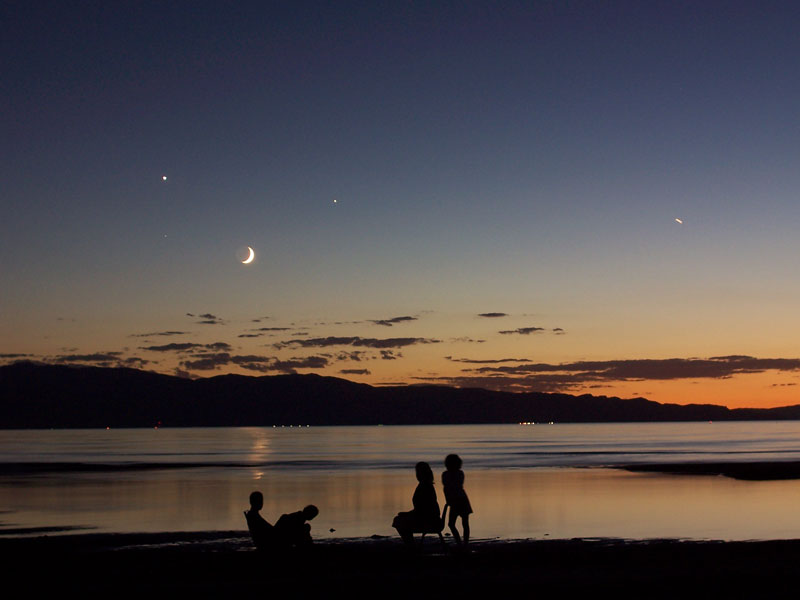
A Quadruple Sky Over Great Salt Lake
Explanation: This was a sky to show the kids. All in all, three children, three planets, the Moon, a star, an airplane and a mom were all captured in one image near Great Salt Lake in Utah, USA on September 6. Minus the airplane and the quadruple on the ground, this busy quadruple coincidence sky was visible last week all over the world. The easiest object to spot is the crescent Moon, which is easily the brightest sky orb in the above image. Venus is the highest planet in the sky, with Jupiter to its right. The bright star Spica completes the quadruple just below Venus. The streak on the far right is an airplane. Mom is seated. Grandpa, appreciating the beauty of the moment, took the picture.
Credit & Copyright: Michael Wilson -
Astronomy Picture of the Day
2005 September 14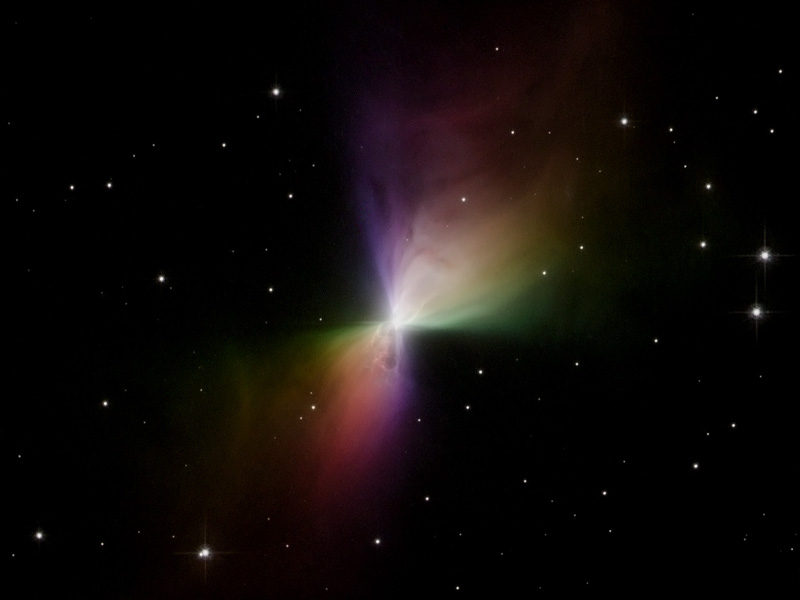
The Boomerang Nebula in Polarized Light
Explanation: Why did the Boomerang Nebula form? The symmetric cloud dubbed the Boomerang appears to have been created by a high-speed wind of gas and dust blowing from an aging central star at speeds of nearly 600,000 kilometers per hour. What confines the wind remains a mystery though -- it may be a central disk of dense gas or a central magnetic field. The rapid expansion itself, however, has cooled molecules in the nebular gas to about one degree above absolute zero - colder than even the cosmic background radiation - making it the coldest known region in the distant Universe. Shining with light from the central star reflected by dust, the frigid Boomerang Nebula is believed to be a star or stellar system evolving toward the planetary nebula phase. To help better understand the Boomerang's origin, astronomers are studying the above image taken in polarized light, color coded by an angular direction associated with the polarization. Different progenitor scenarios create different amounts and patterns of polarized light. The above image was taken by the Hubble Space Telescope's Advanced Camera for Surveys earlier this year. The Boomerang Nebula spans about one light year and lies about 5,000 light years away toward the constellation Centaurus.
Credit: J. Biretta (STScI) et al., Hubble Heritage Team, (STScI/AURA), ESA, NASA -
Astronomy Picture of the Day
2005 September 15
The Nucleus of Comet Tempel 1
Explanation: Approaching the nucleus of comet Tempel 1 at ten kilometers per second, the Deep Impact probe's targeting camera recorded a truly dramatic series of images. Successive pictures improve in resolution and have been composited here at a scale of 5 meters per pixel -- including images taken within a few meters of the surface moments before the July 4th impact. Analyzing the resulting cloud of debris, researchers are directly exploring the makeup of a comet, a primordial chunk of solar system material. Described as a recipe for primordial soup, the list of Tempel 1's ingredients - tiny grains of silicates, iron compounds, complex hydrocarbons, and clay and carbonates thought to require liquid water to form - might be more appropriate for a cosmic souffle, as the nucleus is apparently porous and fluffy. Seen here, Tempel 1's nucleus is about five kilometers long, with the impact site between the two large craters near the bottom.
Credit: Univ. Maryland, JPL-Caltech, NASA -
Astronomy Picture of the Day
2005 September 16
Northern Lights, September Skies
Explanation: So far, the Aurora Borealis or Northern Lights have made some remarkable visits to September's skies. The reason, of course, is the not-so-quiet Sun. In particular, a large solar active region now crossing the Sun's disk has produced multiple, intense flares and a large coronal mass ejection (CME) that triggered wide spread auroral activity just last weekend. This colorful example of spectacular curtains of aurora was captured with a fish-eye lens in skies over Quebec, Canada on September 11. Also featured is the planet Mars, the brightest object above and left center. Seen near Mars (just below and to the right) is the tightly knit Pleiades star cluster. Although they can appear to be quite close, the northern lights actually originate at extreme altitudes, 100 kilometers or so above the Earth's surface.
Credit & Copyright: Philippe Moussette -
Astronomy Picture of the Day
2005 September 17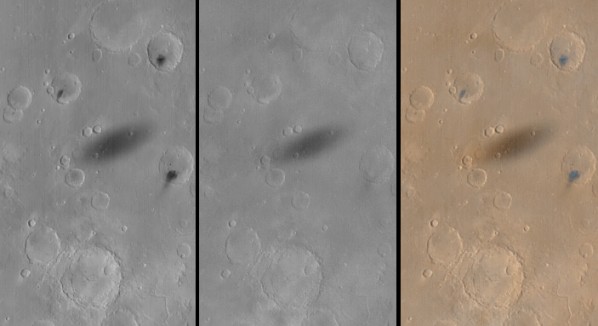
The Shadow of Phobos
Explanation: Hurtling through space above the Red Planet, potato-shaped Phobos completes an orbit of Mars in less than eight hours. In fact, since its orbital period is shorter than the planet's rotation period, Mars-based observers see Phobos rise in the west and set in the east - traveling from horizon to horizon in about 5 1/2 hours. These three images from the Mars Global Surveyor (MGS) spacecraft record the oval shadow of Phobos racing over western Xanthe Terra on August 26, 1999. The area imaged is about 250 kilometers across and is seen in panels from left to right as red filter, blue filter, and combined color composite views from the MGS wide-angle camera system. The three dark spots most easily seen in the red filter image are likely small fields of dark sand dunes on crater floors. Standing in the shadow of Phobos, you would see the Martian version of a solar eclipse!
Credit: Malin Space Science Systems, MGS, JPL, NASA